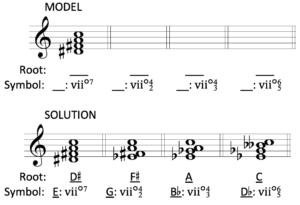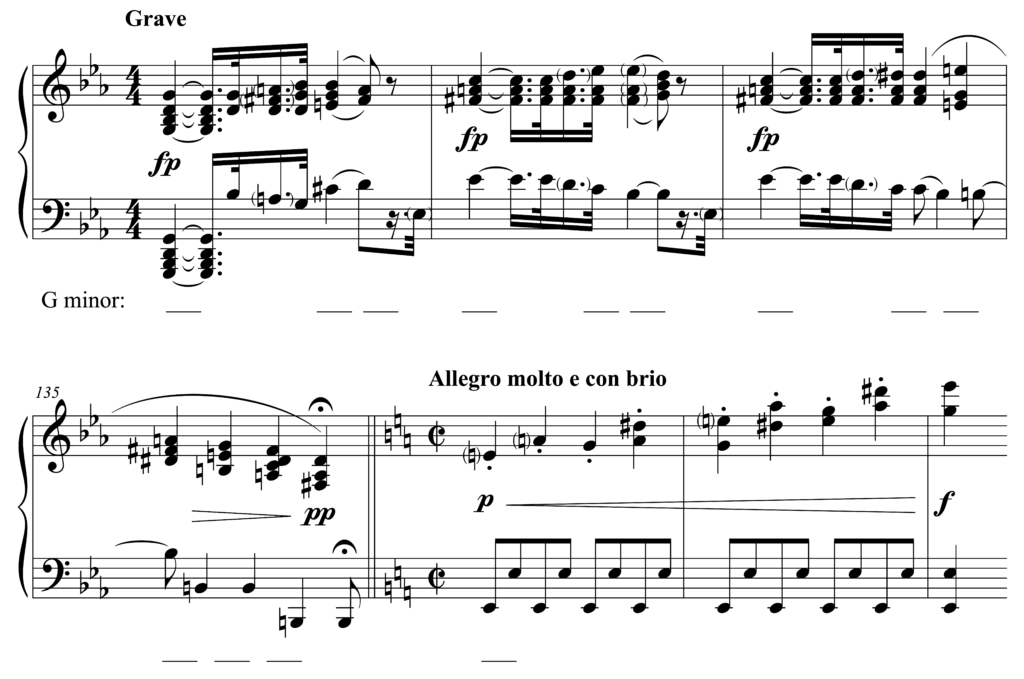Main Body
45 Enharmonic reinterpretation of viio7
Learning goals for Chapter 45
In this chapter, we will learn:
- How the may be used as a means of modulation through enharmonic reinterpretation
- How to respell a fully diminished chord to tonicize four different key areas
Enharmonic equivalence with the fully diminished seventh chord
As an entirely symmetrical chord consisting of minor thirds, the fully diminished seventh chord presents ample opportunity for enharmonic reinterpretation as a means for modulation. Consider four different yet enharmonically equivalent spellings of the fully diminished seventh chord in Example 45‑1. By reinterpreting which member of the chord is acting as a leading tone, the fully diminished seventh chord can potentially tonicize multiple keys. Video T86 walks you through this example.
Example 45‑1. Enharmonically equivalent fully diminished seventh chords
Video: T86 Enharmonic reinterpretation video 4: viio7 chords (12:01)
This video demonstrates how a fully diminished seventh chord can be respelled in order to tonicize four different key areas, working through the enharmonically equivalent chords shown in Example 45-1.
Adding to their complexity, enharmonically reinterpreted fully diminished seventh chords can function as leading-tone chords (viio7) or as secondary diminished chords (viio7/x, where “x” is any major or minor triad). Study the excerpt from Schubert’s Piano Sonata in B![]() major that appears in Example 45-2. Here a secondary diminished seventh chord (viio7/ii) in the tonic key is reinterpreted as the leading-tone chord (viio7) in the distantly related key of F
major that appears in Example 45-2. Here a secondary diminished seventh chord (viio7/ii) in the tonic key is reinterpreted as the leading-tone chord (viio7) in the distantly related key of F![]() minor. At the end of m. 46, the chord is respelled to reflect its new function in the key of F
minor. At the end of m. 46, the chord is respelled to reflect its new function in the key of F![]() minor, but in many cases involving enharmonic reinterpretation, the composer may not respell the chord.
minor, but in many cases involving enharmonic reinterpretation, the composer may not respell the chord.
Example 45‑2. Franz Schubert, Piano Sonata in B![]() major, D. 960, mvt. 1, mm. 42–49
major, D. 960, mvt. 1, mm. 42–49

Listen to the full recording, performed by Arthur Rubenstein, on Spotify.
Learn about Austrian composer Franz Schubert (1797–1828) by reading this Oxford Music Online article, written by Maurice J. E. Brown and others.
Video: T87 Enharmonic reinterpretation video 5: analysis with viio7 (3:15)
This video examines a passage from Schubert’s Piano Sonata in B![]() major, D. 960, mvt. 1 (Example 45‑2), which enharmonically reinterprets a fully diminished seventh chord to get swiftly from the key of B
major, D. 960, mvt. 1 (Example 45‑2), which enharmonically reinterprets a fully diminished seventh chord to get swiftly from the key of B![]() major to F
major to F![]() minor.
minor.
EXERCISE 45-1 Chord spelling and reinterpretation
Respell the given chord, identify the root of each respelled chord, and identify the new keys. The first problem is done as a model.
SET 1
SET 2
EXERCISE 45-2 Analysis with enharmonic reinterpretation
Study and listen to the piece. Identify the key areas and label Roman numerals on the blanks provided beneath the staff (most, but not all, are marked). Then answer the questions below.
- To what key does this excerpt modulate?
- What is the relationship between the opening key of G minor and the new key?
- What kinds of non-chord tones are marked in the second bar, third beat, of this excerpt?
E![]() :______________________
:______________________
A![]() :______________________
:______________________
F![]() :______________________
:______________________
Worksheet example 45‑1. Ludwig van Beethoven, Piano Sonata, no. 8, op. 13, “Pathetique,” mvt. 1, mm. 132–38
Listen to the full recording, performed by Alfred Brendel, on Spotify.
Learn about German composer Ludwig van Beethoven (1770–1827) by reading this Oxford Music Online article, written by Joseph Kerman and others.
Listen to the audio examples featured in this chapter here: Spotify playlist for enharmonic reinterpretation with viio7
Supplemental resources for Chapter 45
Bryn Hughes’s chapter on chromatic modulation (Open Music Theory)
seventh chord spelled as a diminished triad with diminished seventh between root and seventh, forming a stack of all minor thirds
notes that do not belong in a given chord; for example, D would be a non-chord tone in relationship to a C major triad





